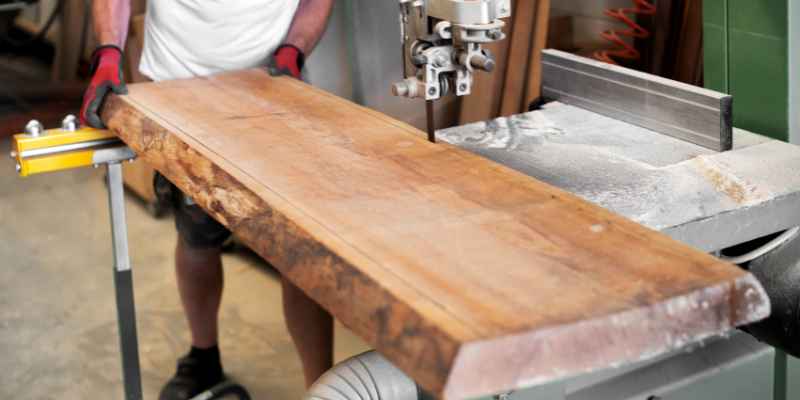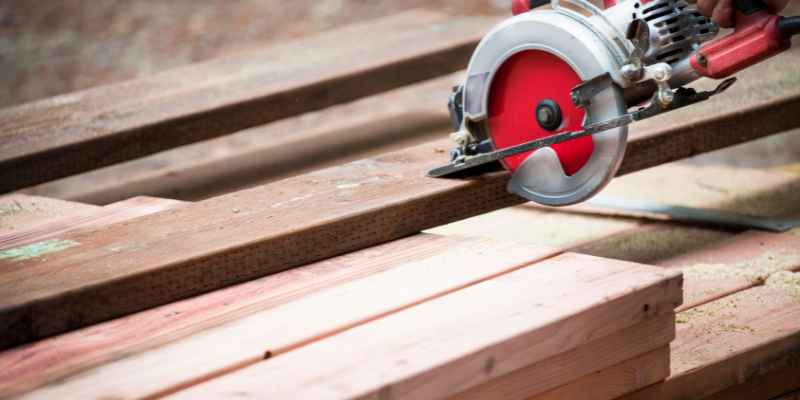To cut a deep slot in wood, use a plunge router with a straight bit. First, mark the desired slot location on the wood.
Then, secure the wood firmly in place and set the router depth to match the slot’s depth. Next, position the router on the marked line and slowly plunge it into the wood, following the desired slot path. Move the router in a smooth and steady motion until the entire slot is cut.
Finally, remove the wood chips and sand the edges for a clean finish. Cutting a deep slot in wood can be a challenging task, but with the right tools and techniques, it can be accomplished effectively. Whether you’re creating a groove for a joint or preparing a piece for a decorative inlay, knowing how to cut a deep slot in wood is a valuable skill for any woodworker.
In this guide, we will explore the step-by-step process of cutting a deep slot using a plunge router, providing you with the knowledge and confidence to tackle this woodworking task with ease. So, let’s dive in and discover the secrets to achieving clean and precise slots in wood.
Introduction To Slot Cutting In Wood
Cutting deep slots in wood is an essential skill for woodworking enthusiasts and professionals alike. Whether it’s for joinery, creating grooves for sliding doors, or making channels for decorative inlays, mastering the art of slot cutting opens up a world of possibilities in woodworking.
The Importance Of Precision
Precision is crucial when it comes to slot cutting in wood. Achieving precise measurements and cuts ensures a snug fit for joints, enhances the aesthetic appeal of the finished piece, and promotes structural integrity. Without precision, the functionality and visual appeal of the woodwork may be compromised.
Applications Of Deep Slots
The versatility of deep slots in wood extends to various applications. From crafting traditional joinery such as mortise and tenon joints to creating channels for installing hardware or inlaying decorative elements, the applications of deep slots are diverse and impactful.
Selecting The Right Tools
When it comes to cutting a deep slot in wood, selecting the right tools is crucial for achieving precise and clean results. Each tool plays a specific role in the process, and choosing the appropriate ones can make the task easier and more efficient.
Choosing A Saw
A saw is an essential tool for cutting deep slots in wood. Circular saws are ideal for making long, straight cuts while jigsaws are suitable for curved or irregular shapes. Band saws are versatile and can handle various depths and angles. Ensure the saw blade is sharp for smooth cuts.
Router And Bits Essentials
A router equipped with a straight bit is perfect for cutting precise and uniform slots. Spiral up-cut bits are excellent for deep cuts, while spiral down-cut bits reduce wood splintering. Compression bits work well with laminated wood for clean edges.
Chisels For Finishing Touches
Chisels are vital for refining and smoothing the edges and surfaces of the slot. Select beveled-edge chisels for trimming and shaping, while paring chisels are ideal for final detailing. Ensure the chisels are sharp for precise and clean finishing touches.
Material Preparation
Before cutting a deep slot in wood, it’s crucial to ensure that you have the right materials and have prepared them appropriately. This includes carefully selecting the wood, marking your cut lines accurately, and gathering the necessary tools for the task.
Wood Selection Criteria
- Choose hardwood with a straight grain for stability.
- Ensure the wood is dry to prevent warping or cracking during cutting.
- Opt for a thickness that accommodates the depth of the desired slot.
- Inspect for knots or imperfections that may affect the cut.
Marking Your Cut Lines
Accurate marking is essential to achieve a precise and clean slot in the wood. Use a ruler and a sharp pencil to mark the beginning and end points of the slot, as well as the edges of the slot. This will guide the cutting process and help maintain accuracy throughout.
Safety First
To ensure safety when cutting a deep slot in wood, always wear protective gear such as goggles and gloves. Use a sharp blade and secure the wood firmly in place before making the cut. Keep your hands at a safe distance from the blade to prevent injuries.
When it comes to woodworking, safety should always be the top priority. Whether you are a professional woodworker or a beginner, it is crucial to understand the importance of personal protective equipment and safe operation of tools. In this article, we will discuss how to cut a deep slot in wood while ensuring safety at all times.
Personal Protective Equipment
Before starting any woodworking project, it is important to wear the appropriate personal protective equipment (PPE). This includes eye protection, ear protection, and respiratory protection. Eye protection is essential to prevent wood chips and sawdust from entering your eyes. Ear protection is necessary to prevent hearing loss caused by loud tools. Respiratory protection is needed to prevent inhalation of sawdust and other particles that can cause respiratory problems.
Safe Operation Of Tools
When cutting a deep slot in wood, it is important to use the appropriate tools and operate them safely. Always use a sharp blade or bit to ensure a clean cut. Make sure the blade is securely attached and the tool is properly adjusted before use. Keep your hands and fingers away from the blade or bit at all times. Never force the tool through the wood, as this can cause kickback and lead to injury. Instead, let the tool do the work and guide it carefully through the wood.
Summary
Cutting a deep slot in wood can be a challenging task, but with the right tools and safety measures, it can be done safely and efficiently. Always wear appropriate personal protective equipment and operate tools safely to prevent injury. By following these guidelines, you can ensure a successful woodworking project while keeping safety a top priority.
Cutting Techniques With A Saw
Cutting Techniques with a Saw involve precise steps to cut a deep slot in wood effectively.
Setting Blade Depth
Adjust saw blade to match desired slot depth before starting the cut.
Making The Initial Cut
Begin by carefully positioning the saw at the starting point of the slot.
Widening The Slot
Gradually move the saw side to side to widen the slot as needed.
Router Techniques For Precision
Achieving precision in wood cutting requires mastering router techniques. To cut a deep slot in wood, start by securing the workpiece and adjusting the router’s depth. Use a straight bit and make multiple passes to reach the desired depth, ensuring accuracy and safety throughout the process.
Router Setup
Before cutting a deep slot in wood, ensure your router is properly set up.
Guided Routing
For precise cuts, use guided routing techniques with a router jig.
Freehand Routing
Alternatively, you can opt for freehand routing for more flexibility.
When cutting a deep slot in wood, using a router can provide accurate and clean results. Proper router techniques are crucial for achieving precision cuts.

Chisel Work For Final Adjustments
Chisels are the perfect tools for making final adjustments to a deep slot in wood. Before you start chiseling, you need to choose the right chisel, refine the edges, and clean the slot bottom. Here are some tips for chisel work that will help you get the job done right.
Chisel Selection
The first step is to select the right chisel for the job. A bevel-edged chisel is the best option for cutting a deep slot in wood. It has a sharp blade that can easily cut through the wood fibers without leaving any marks. You should choose a chisel that is about the same width as the slot you need to cut. If the slot is wider than the chisel, you’ll need to make multiple passes to widen it.
Refining Edges
Once you’ve selected the right chisel, you need to refine the edges. Use a sharpening stone to hone the edges of the chisel to a razor-sharp finish. This will help you get a clean cut and prevent the wood fibers from tearing. Be sure to keep the chisel at a 25-degree angle while sharpening it to ensure a sharp edge.
Cleaning The Slot Bottom
After you’ve cut the slot, you need to clean the slot bottom. Use a chisel to remove any debris or wood chips that may have accumulated at the bottom of the slot. This will help you get a clean finish and prevent the wood fibers from tearing. Be sure to remove any debris from the sides of the slot as well.
Chiseling is a simple yet effective way to make final adjustments to a deep slot in wood. By choosing the right chisel, refining the edges, and cleaning the slot bottom, you can get a clean finish that will make your project look professional.
Finishing The Slot
Learn how to cut a deep slot in wood effectively by using the right tools and techniques. Start by marking the slot, then make multiple passes to achieve the desired depth. Remember to work slowly and safely to ensure precision and accuracy in finishing the slot.
After cutting a deep slot in wood, the next step is to finish it to give it a smooth and polished look. In this section, we’ll discuss sanding techniques and sealing the wood to ensure a perfect finish for your project.
Sanding Techniques
Sanding is an essential step in finishing the slot as it helps to smoothen the rough edges and surfaces of the wood. You can use sandpaper to sand the slot, and it’s recommended to start with a coarse grit and gradually move to finer grits. Here are some sanding techniques to consider:
- Wrap the sandpaper around a dowel or pencil to sand hard-to-reach areas.
- Sand in the direction of the wood grain to avoid scratches.
- Use a sanding block to ensure even sanding.
- Wipe off the dust with a clean cloth after sanding.
Sealing The Wood
Sealing the wood is crucial as it helps to protect it from moisture and other environmental factors that can cause damage. There are different types of sealers you can use, such as varnish, lacquer, or shellac. Here’s how to seal the wood:
- Apply a coat of sealer to the slot using a brush or spray gun.
- Let the sealer dry completely before applying another coat.
- Sand the wood lightly with fine-grit sandpaper between each coat.
- Apply as many coats as needed to achieve the desired finish.
In conclusion, finishing the slot is an essential step in any woodworking project. By following the sanding techniques and sealing the wood, you can achieve a smooth and polished finish that will enhance the beauty and durability of your project.
Troubleshooting Common Issues
Looking to cut a deep slot in wood? Troubleshoot common issues with this handy guide. Discover tips and techniques to achieve the perfect cut without any hassle.
Dealing With Splintering
If splintering occurs when cutting a deep slot in wood, try using a sharp blade to reduce it.
Fixing Uneven Depths
To fix uneven depths, ensure the wood is secure and adjust the cutting depth accordingly.
Addressing Burn Marks
Burn marks can be minimized by using a lower speed and cooling the blade periodically.
Advanced Tips And Tricks
Discover advanced tips and tricks for cutting deep slots in wood. Learn effective techniques to achieve precise and clean results, enhancing your woodworking skills. Master the art of creating intricate designs and functional slots with expert guidance and step-by-step instructions.
Using Jigs For Consistency
When cutting a deep slot in wood, using jigs ensures consistent results.
Multiple Passes For Depth
To achieve the desired depth, make multiple passes with gradual increments.
Achieving Smooth Curves
For smooth curves, adjust the cutting speed and direction accordingly.
Maintaining Your Tools
One of the most important aspects of working with wood is maintaining your tools. Not only does this keep your tools in good condition, but it also ensures that they perform at their best. When it comes to cutting a deep slot in wood, there are several things you need to keep in mind when maintaining your tools. Here are some tips to help you keep your tools in top shape:
Regular Cleaning
Cleaning your tools after each use is essential to keep them in good condition. This is especially important when working with wood, as sawdust and other debris can build up on the blades and bits of your tools. A simple wipe down with a clean cloth after each use can go a long way in preventing rust and other damage.
Sharpening Blades And Bits
Sharp blades and bits are essential when cutting a deep slot in wood. Dull blades can cause uneven cuts and can even damage the wood. It’s important to sharpen your blades and bits regularly to keep them in top condition. You can use a sharpening stone or a file to sharpen your tools, depending on the type of blade or bit you’re using.
Proper Storage
Proper storage is also important when it comes to maintaining your tools. Make sure to store your tools in a dry, cool place to prevent rust and other damage. You can also use toolboxes or other storage containers to keep your tools organized and protected when not in use.
By following these tips for maintaining your tools, you can ensure that they perform at their best when cutting a deep slot in wood. Regular cleaning, sharpening blades and bits, and proper storage are all essential to keep your tools in top condition.

Project Ideas To Practice Slot Cutting
Building A Wooden Box
Start by measuring and cutting the wood pieces for the base, sides, and lid. Use a router to create a deep slot along the edges for a snug fit. Assemble the pieces using wood glue and clamps for a sturdy, functional box.
Creating A Picture Frame
Choose the desired wood and dimensions for the frame. Utilize a router to make a deep slot along the inner edge to hold the picture and glass. Sand and finish the frame for a professional look that showcases your favorite memories.
Crafting Custom Shelving
Design and measure the shelves to fit your space. Use a router to cut deep slots in the shelf supports to hold the shelves securely. Assemble the shelving unit and customize it to match your decor and organizational needs.
Frequently Asked Questions
How Can I Cut A Deep Slot In Wood Effectively?
To cut a deep slot in wood, use a router with a straight bit and make multiple passes gradually increasing the depth. Ensure proper safety gear and stable wood positioning for precision.
What Type Of Saw Blade Is Best For Cutting Deep Slots?
For cutting deep slots in wood, a dado blade is ideal due to its adjustable width. It creates smooth and precise cuts, making it perfect for various woodworking projects.
Is It Necessary To Use A Guide When Cutting Deep Slots?
Using a guide is recommended when cutting deep slots in wood to ensure straight and accurate cuts. Guides help maintain consistency and prevent the blade from wandering off track.
Conclusion
To summarize, cutting a deep slot in wood can be achieved with the right tools and techniques. By following the steps outlined in this blog post, you can ensure a clean and precise cut. Remember to measure accurately, choose the appropriate saw, and take safety precautions.
With practice, you’ll become proficient in creating deep slots for various woodworking projects. Happy cutting!

